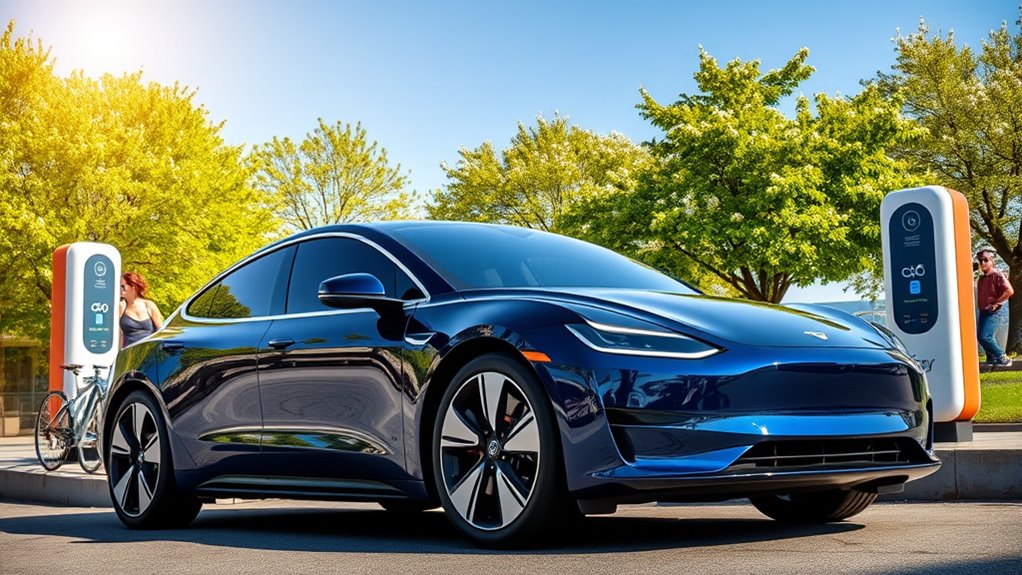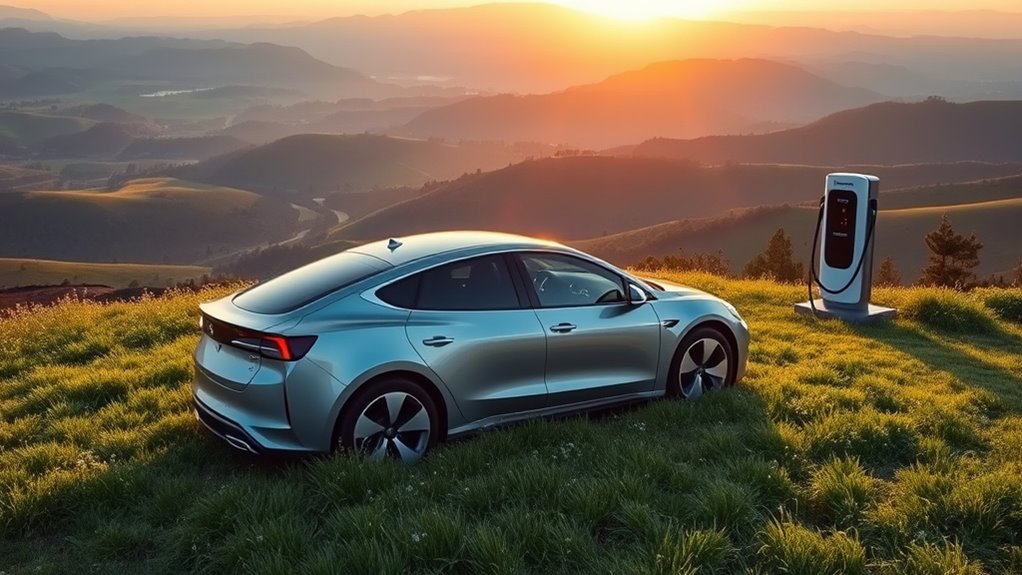When choosing an electric vehicle, focus on battery technology, driving needs, and charging options. Look for a model with a battery capacity that fits your daily and long-distance habits, and consider if you can access fast chargers for trips. verify the vehicle’s charging ports match local infrastructure and explore available charging networks near you. Understanding these factors helps you pick an eco-friendly ride that’s convenient and reliable—exploring further will help you make the best choice.
Key Takeaways
- Assess your daily driving distance and choose a battery capacity that matches your commuting needs.
- Ensure access to reliable charging infrastructure, including home and fast-charging stations, for convenience.
- Consider vehicle range and the availability of fast chargers for long trips and less-developed charging networks.
- Stay informed about technological advancements like solid-state batteries and improved thermal management.
- Match your lifestyle and driving habits with the EV’s features to maximize efficiency, safety, and eco-friendliness.

Are you contemplating switching to an electric vehicle? If so, you’re making a smart choice for the environment and your wallet. But before you buy, it’s vital to understand what makes EVs appealing and what factors influence your overall experience. One of the most essential aspects is battery technology. Modern EV batteries have come a long way, offering increased range, faster charging times, and longer lifespans. Lithium-ion batteries dominate the market because they’re lightweight, efficient, and reliable. As you explore different models, pay attention to the battery capacity—measured in kilowatt-hours (kWh)—since a larger capacity typically means a longer driving range. This is vital if you plan to take long trips or live in an area where charging stations are scarce. Advances in battery technology also mean that EVs are becoming more affordable over time, with better thermal management systems and solid-state batteries on the horizon that promise even greater safety and efficiency. Battery safety improvements are critical as well, ensuring you can drive confidently.
Equally important is the charging infrastructure available in your area. You want to guarantee that charging stations are accessible and convenient, reducing any range anxiety you might have. Home charging options, such as Level 2 chargers, allow you to plug in overnight and start each day with a full battery—making daily commutes hassle-free. Public charging stations, especially fast chargers, can replenish your battery in 30 minutes or less, giving you the flexibility to travel longer distances without long stops. When evaluating a vehicle, check the compatibility of its charging port with local infrastructure. Some newer models support fast charging standards like CCS or CHAdeMO, which are more widely available. It’s also wise to think about apps or networks that help locate nearby charging stations and monitor their status in real-time, ensuring you’re never left stranded.
Thinking about these two factors—battery technology and charging infrastructure—helps you select an EV that fits your lifestyle. If you mostly drive within city limits, a model with a smaller battery might suffice, especially if charging stations are plentiful. But if you frequently go on road trips, a vehicle with a longer range and access to fast chargers becomes more important. Additionally, consider the future growth of charging networks in your area; expanding infrastructure means you’ll have greater flexibility and peace of mind. By focusing on these key elements, you’ll make a more confident, informed decision, guaranteeing that your transition to an electric vehicle is smooth, convenient, and truly eco-friendly.
Frequently Asked Questions
How Do EVS Perform in Extreme Weather Conditions?
In extreme weather conditions, EVs can experience reduced battery efficiency, impacting range and winter performance. Cold temperatures slow down battery reactions, so you might notice less power and longer charging times. To get the best winter performance, you should precondition your vehicle, keep the battery warm, and plan your trips accordingly. Proper maintenance and choosing models with advanced thermal management systems help guarantee your EV performs reliably in challenging weather.
What Are the Long-Term Maintenance Costs for Electric Vehicles?
You’ll likely face lower long-term maintenance costs with an electric vehicle because it has fewer moving parts and no oil changes. However, you should consider battery degradation over time, which can reduce range and performance. Replacement costs for batteries can be significant but are decreasing as technology advances. Overall, your maintenance expenses will be lower compared to traditional gas-powered cars, especially if you keep your EV well-maintained and monitor battery health.
How Do I Find Affordable Charging Stations in My Area?
To find affordable charging stations in your area, start by exploring popular charging networks like Tesla Supercharger, ChargePoint, or Electrify America. Use their apps or websites to check station accessibility and real-time availability. You can also use navigation apps with EV charging features to locate nearby stations, compare prices, and plan your routes efficiently. This way, you guarantee convenient, budget-friendly charging options wherever you go.
Are Used Electric Vehicles as Reliable as New Ones?
Used electric vehicles can be just as reliable as new ones if they’ve been well maintained. Focus on battery longevity, as it impacts performance and resale value. Check the vehicle’s battery health and history before buying. While resale value may decrease with older models, a well-maintained used EV offers dependable performance, making it a smart, eco-friendly choice. Just guarantee you get a thorough inspection to confirm its condition.
What Incentives or Tax Credits Are Available for EV Buyers?
Sure, because who doesn’t love free money? You can snag government rebates and tax incentives when you buy an EV, making it feel like you’re winning the lottery every tax season. These perks cut down your upfront costs and make eco-driving more affordable. So, take advantage of these incentives—they’re your ticket to saving cash while saving the planet, all without breaking a sweat.
Conclusion
As you step into an electric vehicle, you’re holding the key to a greener future. Each charge is a fresh start, a symbol of your commitment to the planet’s well-being. By choosing this path, you’re not just driving—you’re steering the world toward hope and sustainability. Embrace the journey ahead, knowing that your decision fuels change, illuminating a brighter, cleaner horizon for generations to come.









